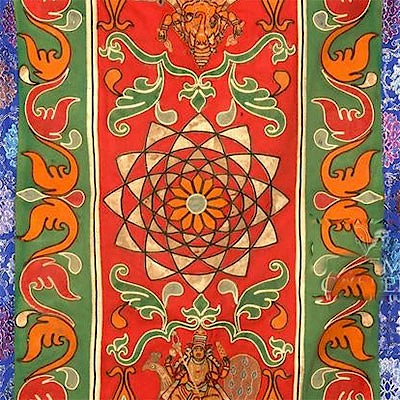19th C. Russian Icon - Joy of All Who Sorrow
Lot 740
About Seller
Artemis Fine Arts
686 S Taylor Ave, Ste 106
Louisville, CO 80027
United States
Selling antiquities, ancient and ethnographic art online since 1993, Artemis Gallery specializes in Classical Antiquities (Egyptian, Greek, Roman, Near Eastern), Asian, Pre-Columbian, African / Tribal / Oceanographic art. Our extensive inventory includes pottery, stone, metal, wood, glass and textil...Read more
Estimate:
$800 - $1,200
Absentee vs Live bid
Two ways to bid:
- Leave a max absentee bid and the platform will bid on your behalf up to your maximum bid during the live auction.
- Bid live during the auction and your bids will be submitted real-time to the auctioneer.
Bid Increments
| Price | Bid Increment |
|---|---|
| $0 | $25 |
| $300 | $50 |
| $1,000 | $100 |
| $2,000 | $250 |
| $5,000 | $500 |
| $10,000 | $1,000 |
| $20,000 | $2,500 |
| $50,000 | $5,000 |
| $100,000 | $10,000 |
| $200,000 | $20,000 |
About Auction
By Artemis Fine Arts
Oct 17, 2019
Set Reminder
2019-10-17 10:00:00
2019-10-17 10:00:00
America/New_York
Bidsquare
Bidsquare : Early Fall Variety | Ancient & Ethnographic
https://www.bidsquare.com/auctions/artemis-gallery/early-fall-variety-ancient-ethnographic-4538
Discover incredible lots relisted with new, lower start prices (up to 50% less), plus many items brand-new to auction. Step back in time and around the world – you’ll be amazed at the treasures you will find. Antiquities from the Classics, Asian, Pre-Columbian African and much more! Artemis Fine Arts info@artemisgallery.com
Discover incredible lots relisted with new, lower start prices (up to 50% less), plus many items brand-new to auction. Step back in time and around the world – you’ll be amazed at the treasures you will find. Antiquities from the Classics, Asian, Pre-Columbian African and much more! Artemis Fine Arts info@artemisgallery.com
- Lot Description
**Originally Listed At $600**
Eastern Europe, Russia, ca. 19th century CE. Elegantly delineated in egg tempera and gold leaf on wood, a Russian icon depicting the blessed Virgin Mary with suffering supplicants asking for her intercession as well as angels to either side. The title of this piece comes from a miracle working icon known by that same name “The Joy of All Who Sorrow” (sometimes "The Joy of All Who Suffer"), and the inscription confirms this theme. Size: 14" L x 12" W (35.6 cm x 30.5 cm)
Notice the banners with passages written on them. These texts usually refer to the Akathist to the Joy of All Who Suffer, most often from Kontakion II which translates, "Beholding the streams of wonders which pour forth from your holy icon, O most blessed Mother of God, in that you are the good helper of those who pray, the support of the oppressed, the hope of the hopeless, the consolation of those who grieve, the nourisher of the hungry, the clothing of the naked, the chastity of virgins, the guide of strangers, the assistance of those who labor, the restoration of sight to the blind, the clear hearing to the deaf, and the healing of the sick, in you we thankfully sing to God: Alleluia!"
The icon that served as inspiration for this example was first believed to create a miracle in the year 1688. A woman named Evfimiya, who was the sister of Patriarch Loachim, suffered from an incurable disease. One day as she was praying, Evfimiya heard a voice who proclaimed, “Evfimiya! Go to the Church of the Transfiguration of my son. There is the image called “Joy of All Who Suffer.” The church was in Moscow where Evfimiy lived. She listened and followed the instructions of the mysterious voice and soon was cured.
Icons were some of the first religious artworks brought to Russia from Byzantium. These sacred pictures of the Greek Orthodox church reached a high point in the Byzantine era, however, the Russians brought their own style to the art of the icon. Icons were initially created for use in churches and processions. In time they became smaller and were used increasingly within households. To this day they remain an important form of visual culture in Russia's orthodox religious community.
Provenance: private E. G. collection, Charlotte, North Carolina, USA
All items legal to buy/sell under U.S. Statute covering cultural patrimony Code 2600, CHAPTER 14, and are guaranteed to be as described or your money back.
A Certificate of Authenticity will accompany all winning bids.
We ship worldwide and handle all shipping in-house for your convenience.
#125278Icon was made from two panels that have separated a bit and there is evidence of an old repair to stabilize their union. Normal surface wear with losses and age cracks commensurate with age. Back slats missing on verso.Condition
- Shipping Info
-
All shipping is handled in-house for your convenience. Your invoice from Artemis Gallery will include shipping calculation instructions. If in doubt, please inquire BEFORE bidding for estimated shipping costs for individual items.
-
- Buyer's Premium



 EUR
EUR CAD
CAD AUD
AUD GBP
GBP MXN
MXN HKD
HKD CNY
CNY MYR
MYR SEK
SEK SGD
SGD CHF
CHF THB
THB














